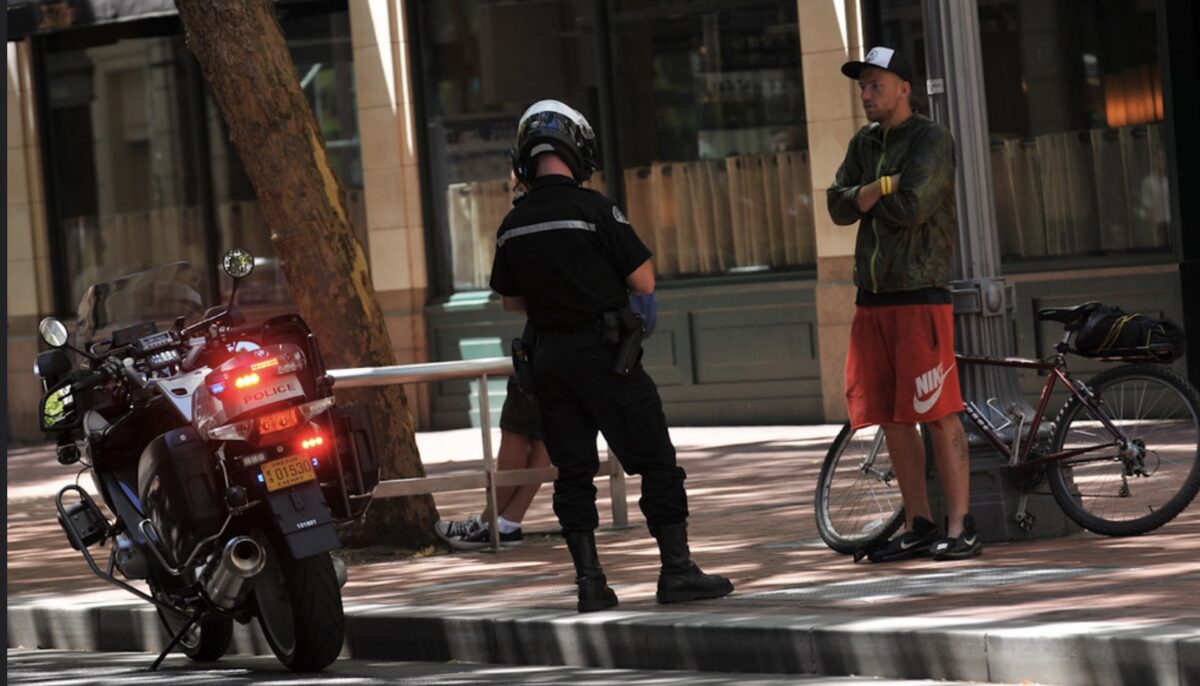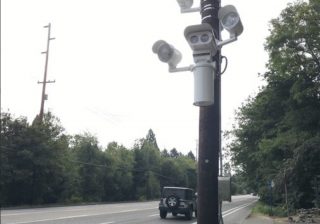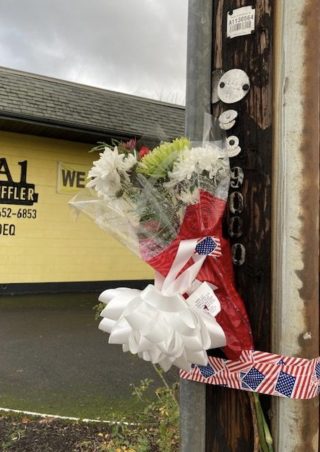
(Photo: Jonathan Maus/BikePortland)
This is the second part of our interview with Portland-based attorney and safety advocate Scott Kocher. In the first half of the interview, Kocher discussed speed limit laws and the “20 is Plenty” campaign. In addition to his legal work, Kocher is on the board of Oregon Walks where he’s working on an in-depth analysis of three years of traffic collisions that killed someone walking. Our conversation has been edited for clarity. (Disclaimer: Kocher’s firm, Forum Law Group, is a financial supporter of BikePortland.)
BikePortland: As a personal injury attorney, you get involved when the system has failed to keep someone safe. I imagine this gives you a unique perspective. What’s your view on enforcement as someone who represents crash victims?

(Photo: Forum Law Group)
Kocher: One of the things I see when I talk to drivers in their depositions is that no one ever thought they’d be the one to cause a terrible crash. Even facing major consequences, the human realities of denial, poor decision-making, and often having major life problems are still there. Seeing that makes me question whether it’s realistic to pin our hopes on people changing their driving behaviors out of fear of killing someone, or going to jail. On top of that, jail or prison isn’t the right place for most of the people who cause serious crashes. Many should not be driving, but sending them to jail has huge personal and social costs, very little deterrence, and is probably less helpful in terms of keeping the community safe than ensuring they transition to not driving as an alternative to incarceration.
As for ticketing, I believe it does have an effect in terms of keeping most drivers within 10 mph of the speed limit, most of the time. That doesn’t mean it’s “working” for safety or other fairness criteria. It’s the other drivers I’m more worried about. And, the way we do ticketing is really broken.
Advertisement
“There’s a lot of potential for simplistic, divisive thinking here. Instead, I see potentially huge win-wins”
BikePortland: This discussion often ends up being framed as a debate between road safety or fairness to people of color for whom a traffic stop can escalate to a traumatic or dangerous interaction with the police. What are your thoughts about that?
Kocher: People sometimes talk about safety as three Es: engineering, education and enforcement. Black Lives Matter has brought increased attention to enforcement. In response, some people have suggested that we can’t support racial justice goals — particularly around interaction between police and the public in the right-of way — because less enforcement would increase dangerous driving behaviors. There’s a lot of potential for simplistic, divisive thinking here. Instead, I see potentially huge win-wins. There’s a pretty big toolkit to improve fairness, reduce police-public interactions and reduce costs in ways that are consistent with eliminating fatal and serious crashes. It includes:
1) Get rid of petty pedestrian offenses. City Code makes it an offense to fail to cross at right angles. The same offenses that are susceptible to being misapplied disproportionately against people who are Black and Brown are the same offenses that were created as part of the early 20th Century transfer of rights from pedestrians to drivers.
2) Before enforcement, engineer streets for safety. No amount of ticketing was going to change the behavior of the man who killed Fallon Smart, or this impaired driver or this one. It should be impossible to drive 50 or 100 mph on our streets.
3) Bring back traffic calming. PBOT got rid of its Traffic Calming Division with budget cuts years ago. Before anyone asks for money for enforcement, ask Council to bring that back, and give it a real budget. Going safe speeds should be intuitive based on how PBOT and ODOT configure and operate their roadways.
Advertisement
4) Where you can’t engineer or calm for safety, replace officer enforcement with cameras. Rotate dummy cameras from place to place, like Sweden does. That way drivers are mostly seeing cameras and slowing down, as opposed to mostly not seeing cameras and getting tickets.

(Photo: PBOT)
5) As a prerequisite for (4), change the fee schedule so that traffic fines go up with income. This would be easy, it costs nothing, and has been successfully implemented elsewhere. It’s unbelievable that we hand somebody a fine that could mean they miss paying rent, while somebody else can pay the same amount over and over and not even care.
6) Change after-hours parking enforcement from police to PBOT. PBOT is set up to do it, because their parking enforcement personnel do it during business hours. Having police respond to calls of improperly parked vehicles on evenings and weekends is expensive, and a setup for racially-charged interactions which have occurred in Portland.
7) Dust off the non-officer enforcement statute, ORS 153.058. This little-known law (a.k.a. the citizen-initiated citation) means you don’t need police officers to enforce most of the laws that are necessary for traffic safety. Non-officers could mean other City employees, such as at PBOT, or other civilians. In the past, PBOT has been reluctant to encroach on traditional police roles, even for minor offenses. Any non-officer enforcement would need to be community-driven, based on need, and implemented with oversight.
8) Last but not least, reassign primary crash response to PBOT. This is overlooked, and potentially a huge deal in terms of reducing police-public interactions by several thousand per year, as well as providing financial and safety benefits.
Advertisement
“I was stunned that Oslo had only one fatality last year. One. It makes me think we can turn our numbers around.”
BikePortland: You expose yourself to a lot of tragedy, which has got to be difficult. Does your activism make that easier? What’s the balance there?
Kocher: I haven’t really analyzed it too much, but as a person who walks and bikes for most trips, and professionally is working with families after crashes… I can’t imagine being confronted with a problem, over and over, and not trying to do something about it. Beyond counteracting burnout, there’s meaning in working with people on fixes that we can see right here in our neighborhoods. I was stunned that Oslo had only one fatality last year. One. It makes me think we can turn our numbers around. (Note: Portland’s 55th traffic fatality of 2020 happened on December 23rd.)
BikePortland: When I take account of all the people I’ve known who have been injured or killed in a car crash, it’s staggering.
Kocher: One in 103 of us will be killed in a car crash. If you have two kids, that makes it about one in fifty that you will lose one of them in a car crash, over a lifetime. There are around 60 people injured for every fatality. It is staggering. Just like there are car dealerships and auto body shops, there are entire industries — including insurance companies and thousands of us lawyers who could be doing other things — that are built around car crashes.
BikePortland: Given your analysis of these tragedies, what do you think are the next steps Portland should take to keep people safe?

(Photo: Lisa Caballero/BikePortland)
Kocher: Provide street lighting with adequate brightness and uniformity, especially on east Portland arterials. Take trees into account when placing lights. Every place crashes are happening, slow it down. Use the speed setting laws we have, and traffic calming, even on bigger streets, in every neighborhood. We’re operating a system of humans, vehicles and streets, each with known characteristics. Something as simple as narrowing the lane widths can make a difference.
And don’t have drivers turning across the crosswalk at the same time as the walk signal phase.
If a street doesn’t have sidewalks, understand that people of all ages and abilities will be walking and biking in that street. Every shared use street needs to be a speed you’d be OK with your 11-year-old walking on alone. Understand that people experiencing homelessness are living along some of our most dangerous streets. Each agency, including transportation, has the same duties to them as to housed Portlanders. Understand that humans come in all shapes and sizes, and states of mind. We will make human errors. The consequence should not be death.
Keep listening to people. Try new things. This list might be different in five years.
As we enter the new year with a dedication to police reform and racial justice and a new commissioner-in-charge of PBOT, we’re in an opportune policy window to figure out which tools are going to work best, and make a change.


